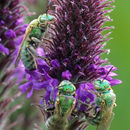en
names in breadcrumbs


The genus Agapostemon (literally "stamen loving") is a common group of Western Hemisphere sweat bees.
They are members of the family of bees known as Halictidae. Unlike other sweat bees, they are not attracted to human sweat.[1] They are generally green or blue, especially the head and thorax. Sometimes the abdomen in females is green or blue although it may be striped, and most males have the yellow-striped abdomen on a black or metallic background. They superficially resemble various members of another tribe, Augochlorini, which are also typically metallic green.
All species of Agapostemon nest in the ground, sometimes in dense aggregations. Some species are communal such as A. virescens. In this and other communal species, multiple females share the same nest entrance, but beneath the common entrance burrow, construct their own portion of the nest. Thus each female digs her own brood cells and collects pollen and nectar to fashion the pollen ball upon which she will lay an egg.
Unlike other social bees, in communal bees there is no reproductive division of labor. The advantage of this form of sociality seems to be that kleptoparasitic Nomada bees have greater difficulty gaining access to the nest and brood cells when there are multiple females inside. This method of defense against the Cuckoo bee (Nomada) facilitates attacks by larvae of the Blister beetle.
Some 42 species in the genus range from Canada to Argentina . In cool temperate regions, there is one generation per year, with females being active in the early summer and males and pre-diapausing females active in the late summer. Only mated females survive the winter. This is probably because unmated females cannot enter diapause.[2] Males can often be seen in large numbers flying around shrubs with large flowers, such as Rose of Sharon. Agapostemon angelicus are native to the Texas high plains. They specialized in being pollinators for cotton.[3] They can serve as replacement for honey bees in pollination[4]
Like other bees, A. texanus can fly from a short or long distance. Their flight patterns usually rely on flower density; they favor flowers with high densities. Their flight patterns best resemble the bumble bee and the honey bee.[5]
Over 40 species of Agapostemon have been identified:[6]
The genus Agapostemon (literally "stamen loving") is a common group of Western Hemisphere sweat bees.
They are members of the family of bees known as Halictidae. Unlike other sweat bees, they are not attracted to human sweat. They are generally green or blue, especially the head and thorax. Sometimes the abdomen in females is green or blue although it may be striped, and most males have the yellow-striped abdomen on a black or metallic background. They superficially resemble various members of another tribe, Augochlorini, which are also typically metallic green.